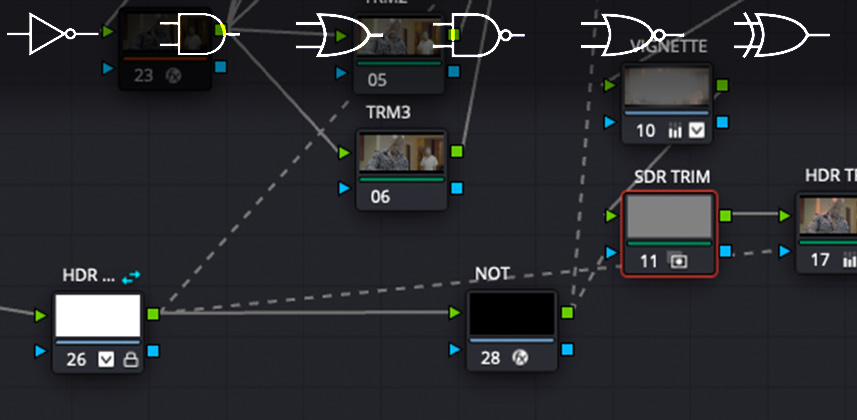| Series |
|---|
Binary Logic: The Basis Of Computing
It’s no secret that I’m a bit of a computer history nerd. The evolution of computing has always fascinated me, which recently had me thinking about the very basics that go into what makes a computer work.
So what do the building blocks of computing have to do with color grading? Well – let’s start at the beginning.
Binary logic describes functions done using inputs and outputs that consist only of true or false (represented by 1 or 0) values.
This is the smallest building block of modern computing. Data is represented entirely in 1s and 0s, and mathematical instructions to that data are done in binary. Inputs are fed into logic gates – which then provide an output based on the content of those inputs.

Computing devices like CPUs use transistors (small, electronic switches) to make these logic gates, and then combine millions of them into the complex processors we know of today.
Logic On The Resolve Color Page
The power of Resolve’s node based color grading got me thinking – what if I could use nodes on the color page as if they were binary logic gates? How could I use that concept to improve my grading workflow?
The first step is representing binary digits with color nodes. This was easy enough – I just used a solid color of black for 0, and white for 1.
The next step was figuring out how to use these 1 and 0 controls to adjust other nodes. This was also simple – by feeding the white or black color generator into the key input of any node, I could control weather that node was active or not!
From there – I actually went through the tedious task of mapping out all the types of logic gates using blending modes and layer mixers. At their core – most blending modes are simple logical operations done to each pixel in an image. For example, the difference blending mode is essentially an XOR gate, while multiply is an AND gate.
Finally – I put them all together in the most complex node tree I’ve ever built. I assembled a working binary adder circuit right on the Color page. That’s right – I turned a color node tree into a very basic, but functional calculator.

From Theory To An Real, Usable Workflow
As fun as playing with logic gates to make the color page do silly things is – I really do think the idea of using logic switches to control a node tree has powerful workflow possibilities. That’s what this Insight is really all about.
In practice this means a node tree which can switch from HDR to SDR at any time. Not only does the output switch, but multiple other trim nodes, highlight nodes, or any other nodes you choose all toggle simultaneously.
Essentially this allows you to grade in HDR and SDR simultaneously, with shot by shot changes for each version always live in a single timeline.

This workflow is based around my Custom ACES node tree. But the concept could be applied to any fixed node structure. The key is to plan out exactly how you want the tree to be controlled. Then build and test it, and keep to that fixed structure.
If you’re head hurts already, don’t worry! I’ll explain the mechanics and uses of all this in practical way in the video below
As always – leave me any comments or questions below!
-Joey
Member Content
Sorry... the rest of this content is for members only. You'll need to login or Join Now to continue (we hope you do!).
Need more information about our memberships? Click to learn more.
Membership optionsMember Login



